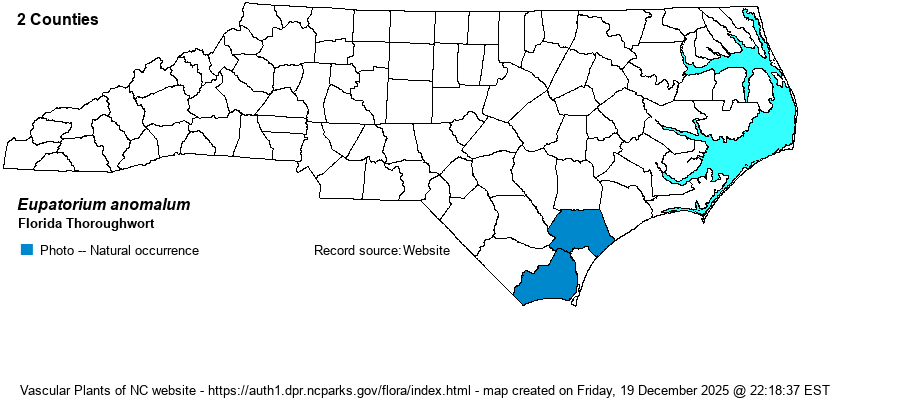| Author | Nash | |
| Distribution | Identification of NC specimens is highly uncertain, owing to being recently split out from E. recurvans; they were collected in Bladen, Brunswick, Carteret, Columbus, Dare, Duplin, New Hanover, Pamlico, and Pender counties. If specimens are correctly identified, it occurs at scattered sites along and close to the southern coast, ranging north to Dare County. The BONAP map shows several coastal NC counties (and one for southeastern VA), but these (at least VA and Dare County) actually are the newly described E. maritimum. Weakley (2024) states that the range is north to eastern NC, and his map does show "rare" for the NC Coastal Plain. In fact, Weakley has photos on iNaturalist that have been vetted by another expert from Brunswick County, and there are other vetted photos there from Pender County. The website editors prefer to remain very cautious and not map any of the records onto the county range map, except for one from Pender County in the NCU collection, and the ones from Brunswick County on iNaturalist, at the present time. However, even the Pender collection is not a positive ID, since it reads :Eupatorium aff. anomalum.
A Southeastern species ranging north to eastern SC, and apparently (but not conclusively) to eastern NC. It ranges south to central FL and southern MS. | |
| Abundance | Of uncertain presence in the state, though perhaps rare, assuming correct identifications of specimens. The NCNHP gives it a State Rank of S1 and tracks it (as of late 2022) as Significantly Rare. Because of the uncertain identification of existing specimens, a State Rank of S1? might be better, to indicate some lack of clarity on its range and abundance in NC. | |
| Habitat | This is a species of wet pine savannas and flatwoods. Weakley (2024) says: "Moist pine savannas, coastal plain pondshores, moist interdune swales." |
| Phenology | Flowering and fruiting August-October. | |
| Identification | All NC specimens need careful checking. From the Weakley (2018) key, this species and the closely related E. recurvans, plus E. mohrii, all have narrowly cuneate leaf bases, "the leaves generally broadest near the middle or toward the tip". These species also are "Plants from conspicuously tuberous-thickened (about 1 cm in diameter) horizontal rhizomes" (i.e., emerging singly from the ground) as opposed to emerging from crowns. And, this particular species has much wider leaves than the other two -- 15-30 mm wide, spreading or ascending, versus only 2-12 mm wide and deflexed to erect-ascending in E. recurvans and E. mohrii. The wide leaves with strongly serrated margins, for a savanna Eupatorium species, is a clue that you might have this species. | |
| Taxonomic Comments | This is one of several species formerly included within E. recurvans. The newly described E. maritimum (which see) is known from Dare, Tyrrell, and Carteret counties and specimens were formerly determined as E. anomalum.
| |
| Other Common Name(s) | None | |
| State Rank | S1 | |
| Global Rank | G2G3 | |
| State Status | SR-T | |
| US Status | | |
| USACE-agcp | FACU link |
| USACE-emp | FACU link |

